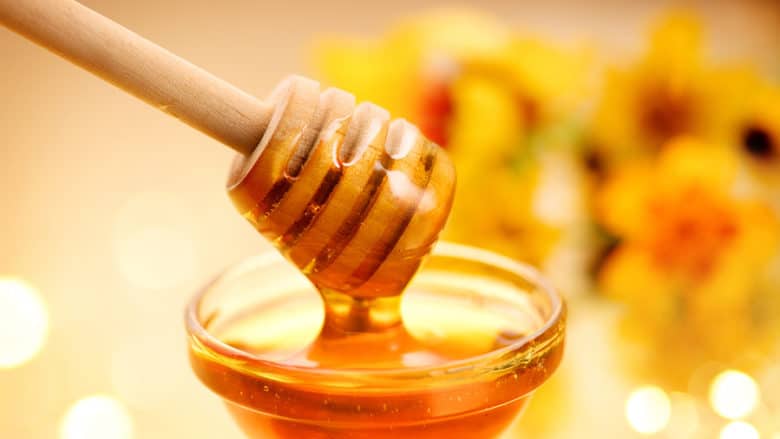
Honey benefits begin as the honey bees fly from flower to flower sipping sweet nectar while disseminating and collecting golden pollen with their hind legs.
They return to their hive and join with other honey bees in using their “honey stomachs” to ingest and regurgitate the nectar until it is transformed into honey.
After storing the honey in honeycomb cells, the bees fan their wings. The air currents they create evaporate just the right amount of water to raise sugar content and prevent fermentation, thus preserving the honey.
The bees and the plants create an energy rich food source with over 600 known properties, while they assure the continued flowering of the plants through cross pollination.
If it weren’t for the honey bee’s pollinating blossoms, 80 percent of plants would not go to full bloom.
Honey benefits result from this fascinating work and are specific to the flowers visited by the bees.
Honey Benefits
1. Nutrition
Honey consists mostly of sugars (carbohydrates) along with trace amounts of other nutrients. Although the nutrients vary depending on the type of honey, on average, one tablespoon provides 64 calories and the following nutrients measured in grams (g) ( Nutrient Database):
Sugars (total): 15.25 g
Sucrose: 0.19 g
Glucose (Dextrose): 7.51g
Fructose: 8.60 g
Maltose: 0.30 g
Galactose: 0.65
Trace nutrients include vitamins (vitamin C, riboflavin, niacin, pantothenic acid, vitamin B6, choline, betaine), amino acids, and minerals (calcium, iron, phosphorous, potassium, sodium, zinc, copper, manganese, fluoride, selenium).
As a general rule, darker honey has more vitamins and minerals than lighter honey.
Honey counts as a moderately desirable sugar/sweetener source with a glycemic index of 55 and a glycemic load of 10.
2. Energy Booster
Honey is a quick, easy, and natural source of energy. The carbohydrates in honey provide the energy for muscles to do their work, plus they help maintain muscle glycogen.
Glycogen acts as an energy reserve that can be drawn on when carbohydrates aren’t available in the blood stream.
3. Beauty Enhancer
Honey naturally attracts and retains moisture making it a great moisturizer. Look for it in moisturizing products including cleansers, creams, shampoos and conditioners.
You can also simply add a squeeze to your soap or moisturizer at home or whip up your own recipe like Cucumber Honey Eye Moisturizer.
4. Cough Suppressant
A small spoon of honey works better than over the counter cough suppressants.
Researchers at Penn State University found that buckwheat honey given before bedtime provided better relief of nighttime cough and sleep difficulty in children than dextromethorphan (DM) found in many cough medicines, and without DM’s side effects.
5. Wound Healing
People have probably used honey to heal burns, cuts and scrapes since time began. Now, science documents that certain types of honey may promote natural wound healing.
A review of 20 studies with over 2000 patients published in the International Journal of Lower Extremity Wounds concluded that honey treatment of wounds had the the following benefits:
- Quickly clears up existing wound infections
- Protects against further infection
- Reduces swelling
- Minimizes scarring
- Helps remove infected and dead tissue
- Speeds healing by stimulating new tissue growth
One of the most fascinating reasons posed for honey’s healing effect is an enzyme added by bees that results in the formation of small amounts of hydrogen peroxide, an effective germicide against many bacteria.
Manuka honey of New Zealand and Medihoney, developed in Australia, are most commonly used in treating serious wounds. These honeys also receive special treatment to remove disease causing clostridial spores before use.
Consider using honey for mild wounds and burns, and have a health professional assess and treat serious wounds.
6. Chronic Sinusitis
Manuka and Sidr honey may offer real hope for those who suffer with chronic sinusitis. This difficult to treat condition causes headaches, congestion, and difficulty breathing. Sinusitis may be caused by allergy or bacteria or a combination of the two.
Both Manuka and Sidr honey prove effective in killing the bacteria that cause chronic sinusitis, including superbugs like MRSA (methicillin-resistant Staphlococcus aareus) and MSSA (methicillin-susceptible Staphlococcus aureus), report researchers at the University of Ottawa.
Manuka honey comes from the manuka bush, also known as the tea tree bush, in New Zealand. Sidr honey comes from the sidr tree in Yemen, an ancient and sacred tree mentioned in spiritual texts.
Other honeys were included in the study, but were removed when they did not show the same level of bacteria killing effects.
Scientists hope these studies can help develop new treatments for people with chronic sinusitis.
Allergies
Some claim that eating local honey helps allergies based on the belief that the pollen content in the honey will inoculate them against the allergens. However, few controlled studies have addressed this theory, reports ConsumerLab.com.
Safety
Honey, a natural food, has no side effects. It is safe except for infants one year or younger who should never be given honey due to their under-formed intestinal tract and the risk of infant botulism.
Key Points
Honey benefits for natural healing have been known throughout the ages.
Now scientific studies validate that specific kinds of honey may help treat wounds, coughs, and chronic infections. In some of these studies, honey actually outperformed pharmaceuticals and without their nasty side effects.
Honey is safe except for infants 12 months or younger, so why not try some of these honey benefits?
Sources and Resources
Alandejani, T., et.al., “Effectiveness of Honey on Staphylococcus Aureus and Pseudomonas Aeruginosa Biofilms,” Otolaryngology — Head and Neck Surgery, August 2008, vol 139, issue 2, supp 1: p 107.
Colihan, K. “Humble Honey Bee Kills Bacteria,” WebMD Health News, http://www.webmd.com/cold-and-flu/news/20080922/humble-honey-kills-bacteria.
ConsumerLab.com, “Honey,” http://www.consumerlab.com/tnp.asp?chunkiid=155289&docid;=/tnp/herbs_supps/honey#P1.
Molan, P.C., “The Evidence Supporting the Use of Honey as a Wound Dressing,” International Journal of Lower Extremity Wounds, March 1, 2006.
Penn State University. “Honey A Better Option For Childhood Cough Than Over The Counter Medications.” ScienceDaily, 3 Dec. 2007. Web. 27 Oct. 2011.
Waikato Honey Research Unit at http://bio.waikato.ac.nz/honey.
